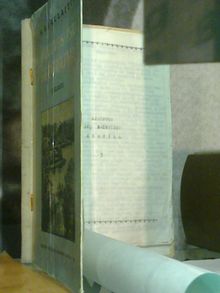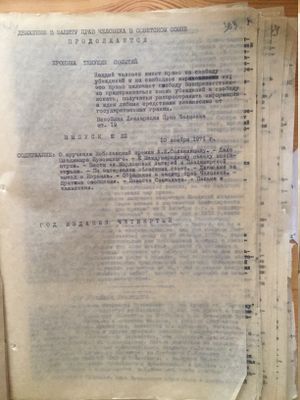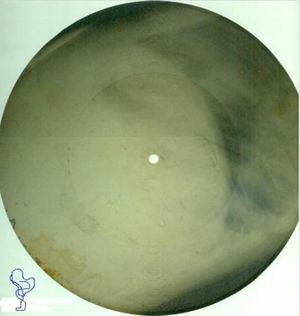ساميزدات
| ساميزدات | |
 Russian samizdat and photo negatives of unofficial literature | |
| الروسية | самиздат |
|---|---|
| الرومنة | [ساميزدات] Error: {{Lang}}: Non-latn text (pos 1: س)/Latn script subtag mismatch (help) |
| المعنى الحرفي | نشر ذاتي |
| جزء من سلسلة عن |
| ثورة |
|---|
 |
|
|
ساميزدات (روسية: самизда́т؛ Samizdat ؛ حرفياً "نشر ذاتي") was a form of dissident activity across the Eastern Bloc in which individuals reproduced censored and underground makeshift publications, often by hand, and passed the documents from reader to reader. The practice of manual reproduction was widespread, due to the fact that most typewriters and printing devices were inventorized and required permission to access. This grassroots practice to evade official Soviet censorship was fraught with danger, as harsh punishments were meted out to people caught possessing or copying censored materials.
Vladimir Bukovsky summarized it as follows:
"Samizdat: I write it myself, edit it myself, censor it myself, publish it myself, distribute it myself, and spend time in prison for it myself."[1]
أصل الاسم وتنويعات
Etymologically, the word samizdat derives from sam (روسية: сам, "self, by oneself") and izdat (روسية: издат, an abbreviation of издательство, izdatel'stvo, "publishing house"), and thus means "self-published". The Ukrainian language has a similar term: samvydav (самвидав), from sam, "self", and vydavnytstvo, "publishing house".[2]
The Russian poet Nikolai Glazkov coined a version of the term as a pun in the 1940s when he typed copies of his poems and included the note Samsebyaizdat (Самсебяиздат, "Myself by Myself Publishers") on the front page.[3]
Tamizdat refers to literature published abroad (там, tam, "there"), often from smuggled manuscripts.[4]
التقنيات
All Soviet-produced typewriters and printing devices were inventorized, with their typographic samples collected right at the factory and stored in the government directory.[بحاجة لمصدر] Because every typewriter has micro features which are individual as much as human fingerprints, it allowed the KGB investigators to promptly identify the device which was used to type or print the text in question, and apprehend its user.[بحاجة لمصدر] However, certain East German and Eastern European-made Cyrillic typewriters, most notably the Erika, were purchased by Soviet citizens while travelling to nearby socialist countries, skipped the sample collection procedure and therefore presented more difficulty to trace. Western-produced typewriters, purchased abroad and somehow brought or smuggled into the Soviet Union, were used to type Cyrillic text via Latin characters. To prevent capture, regular bookbinding of ideologically-approved books have been used to conceal the forbidden texts within.
"Эрика" берёт четыре копии,
Вот и всё!
...А этого достаточно.
The "Erika" takes four copies,
That is all!
...But that is enough.
— Alexander Galich on the Erika typewriter commonly used for carbon copies in Russian samizdat production.[5]
Samizdat copies of texts, such as Mikhail Bulgakov's novel The Master and Margarita or Václav Havel's essay The Power of the Powerless were passed around among trusted friends. The techniques used to reproduce these forbidden texts varied. Several copies might be made using carbon paper, either by hand or on a typewriter; at the other end of the scale, mainframe computer printers were used during night shifts to make multiple copies, and books were at times printed on semiprofessional printing presses in much larger quantities. Before glasnost, most of these methods were dangerous, because copy machines, printing presses, and even typewriters in offices were under control of the organisation's First Department (part of the KGB); reference printouts from all of these machines were stored for subsequent identification purposes, should samizdat output be found.
الصيغة الطبيعية

Samizdat distinguishes itself not only by the ideas and debates that it helped spread to a wider audience but also by its physical form. The hand-typed, often blurry and wrinkled pages with numerous typographical errors and nondescript covers helped to separate and elevate Russian samizdat from Western literature.[6] The physical form of samizdat arose from a simple lack of resources and the necessity to be inconspicuous. In time, dissidents in the USSR began to admire these qualities for their own sake, the ragged appearance of samizdat contrasting sharply with the smooth, well-produced appearance of texts passed by the censor's office for publication by the State. The form samizdat took gained precedence over the ideas it expressed, and became a potent symbol of the resourcefulness and rebellious spirit of the inhabitants of the Soviet Union.[7] In effect, the physical form of samizdat itself elevated the reading of samizdat to a prized clandestine act.[8]
التاريخ
Self-published and self-distributed literature has a long history in Russia. Samizdat is unique to the post-Stalin USSR and other countries with similar systems. Faced with the police state's powers of censorship, society turned to underground literature for self-analysis and self-expression.[9]
دوريات ساميزدات

الأدبية

التسجيلات المهربة
Ribs, "music on the ribs", "bone records",[10] or roentgenizdat (roentgen- referring to X-ray, and -izdat implying samizdat) were homemade phonograph records, copied from forbidden recordings that were smuggled into the country. Their content was Western rock and roll, jazz, mambo, and other music, and music by banned emigres. They were sold and traded on the black market.
دوريات ساميزدات البارزة
انظر أيضاً
- Censorship in the Soviet Union
- Eastern Bloc media and propaganda
- Gosizdat
- Human rights in the Soviet Union
- Political repression in the Soviet Union
- USSR anti-religious campaign (1970s–1987)
الهامش
- ^ Bukovsky 1979, p. 141.
- ^ Balan 1993.
- ^ Komaromi 2004, p. 598.
- ^ Kind-Kovács & Labov 2013, p. 19 fn. 1.
- ^ Etkind 1992, p. 597.
- ^ Komaromi 2004, pp. 608–609.
- ^ Komaromi 2004, p. 609.
- ^ Komaromi 2004, p. 605.
- ^ Alexeyeva 1987, p. 12.
- ^ NPR 2016.
المصادر العامة
- Bukovsky, Vladimir (1979). To Build a Castle: My Life as a Dissenter. New York: Viking Press. ISBN 978-0-670-71640-1.
- Balan, Borys (1993). "Samvydav". In Kubijovyč, Volodymyr (ed.). Encyclopedia of Ukraine. 4: Ph - Sr. Toronto: Univ. of Toronto Press. ISBN 978-0-8020-3994-1.
{{cite book}}: External link in|chapterurl=|chapterurl=ignored (|chapter-url=suggested) (help) - Kind-Kovács, Friederike; Labov, Jessie, eds. (2013). Samizdat, Tamizdat, and Beyond: Transnational Media During and After Socialism. Studies in contemporary European history. New York: Berghahn Books. ISBN 978-0-85745-585-7.
- Feldbrugge, F. J. M. (1975). Samizdat and Political Dissent in the Soviet Union. Leyden: A.W. Sijthoff. ISBN 978-90-286-0175-8.
- Alexeyeva, Ludmilla (1987). Soviet Dissent: Contemporary Movements for National, Religious, and Human Rights. Carol Pearce, John Glad (trans.). Middletown, Conn.: Wesleyan University Press. ISBN 978-0-8195-6176-3.
- Crump, Thomas (2013). Brezhnev and the Decline of the Soviet Union. Routledge Studies in the History of Russia and Eastern Europe. Routledge. ISBN 978-1-134-66922-6.
- Urban, Michael E.; Igrunov, V.; Mitrokhin, S. S. (1997). The Rebirth of Politics in Russia. Cambridge; New York: Cambridge University Press. p. 87. ISBN 978-0-521-56248-5.
- Reddaway, Peter (1972). Uncensored Russia – protest and dissent in the Soviet Union. The unofficial Moscow journal, A Chronicle of Current Events. New York: American Heritage Press. ISBN 978-0070513549.
- Кашин, Олег (June 2009). ""Настоящий диссидент, только русский". Вспоминает ветеран многоподъездной системы" [A true dissident, only a Russian one. A veteran of the multi-podyezd system remembers]. «Русская жизнь».
- Meerson-Aksenov, Mikhail Georgievich; Shragin, Boris Iosifovich (1977). The Political, social, and religious thought of Russian samizdat: an anthology. Belmont, MA: Nordland Pub. Co. ISBN 978-0-913124-13-0.
- Komaromi, Ann (2004). "The Material Existence of Soviet Samizdat". Slavic Review. 63 (3): 597–618. doi:10.2307/1520346. JSTOR 1520346.
- Joo, Hyung-min (June 2004). "Voices of freedom: samizdat". Europe-Asia Studies. 56 (4): 571–594. doi:10.1080/0966813042000220476. JSTOR 4147387.
- Stelmakh, Valeria D. (Winter 2001). "Reading in the Context of Censorship in the Soviet Union". Libraries & the Cultural Record. 36 (1): 143–151. doi:10.1353/lac.2001.0022. ISSN 1932-9555. Retrieved 2016-04-30.
- Kind-Kovács, Friederike; Labov, Jessie (2013). "Samizdat and Tamizdat". In Friederike Kind-Kovács; Jessie Labov (eds.). Samizdat, Tamizdat, and Beyond: Transnational Media During and After Socialism. Studies in contemporary European history. New York: Berghahn Books. pp. 1–29. ISBN 978-0-85745-585-7.
- Etkind, Efim (1992). "Afterword: Russian literature in the 1980s". In Charles Moser (ed.). The Cambridge History of Russian Literature. Cambridge: Cambridge University Press. pp. 595–614. ISBN 978-1-139-05544-4.
{{cite book}}: External link in|chapterurl=|chapterurl=ignored (|chapter-url=suggested) (help) - "Bones And Grooves: The Weird Secret History Of Soviet X-Ray Music". NPR. 9 January 2016.
- "samizdat". Jargon File 4.4.8. Eric Raymond. 2004-10-01. Retrieved 2016-04-22.
- Raymond, Eric S. (1996). The New Hacker's Dictionary (3rd ed.). Cambridge, MA: MIT Press. pp. 395–396. ISBN 978-0-262-18178-5.
للاستزادة
أعمال من الخارج
- Samizdat 1 – La voix de l'opposition communiste en U.R.S.S. [Samizdat 1 – The voice of the communist opposition in the USSR] (in French). Paris: Seuil. 1969. ASIN B00R4QXXSO.
{{cite book}}: CS1 maint: unrecognized language (link) - Samizdat: cronaca di una vita nuova nell'Urss [Samizdat: chronicle of new life in the USSR] (in Italian) (2 ed.). Milan: La Casa di Matriona. 1977 [1975].
{{cite book}}: CS1 maint: unrecognized language (link) - "The press: samizdat West". Time. 105 (15). 14 April 1975.
- Woman and Russia: first feminist samizdat. Sheba Feminist Publishers. 1982. ISBN 978-0907179023.
- Allen, Charles (1980). "Trends in economic samizdat". The Fletcher Forum of World Affairs. 4 (4): 93.
- Aron, Leon (July–August 2009). "Samizdat in the 21st century. Russia's new literature of crisis". Foreign Policy (173): 131–133. JSTOR 20684899.
- Barghoorn, Frederick (Spring–Summer 1983). "Regime-dissenter confrontation in the USSR: samizdat and Western views, 1972–1982". Studies in Comparative Communism. 16 (1–2): 99–119. doi:10.1016/0039-3592(83)90046-7.
- Bloom, Harry (June 1973). "The end of samizdat? The Soviet Union signs the universal copyright convention". Index on Censorship. 2 (2): 3–18. doi:10.1080/03064227308532216.
- Boiter, Albert (July 1972). "Samizdat: primary source material in the study of current Soviet affairs". The Russian Review. 31 (3): 282–285. doi:10.2307/128049. JSTOR 128049.
- Bowlt, John (1986). Russian samizdat art: essays. Willis Locker & Owens Pub. ISBN 978-0930279042.
- Brun-Zejmis, Julia (Autumn 1991). "Messianic consciousness as an expression of national inferiority: Chaadaev and some samizdat writings of the 1970s". Slavic Review. 50 (3): 646–658. doi:10.2307/2499860. JSTOR 2499860.
- Brun-Zejmis, Julia (June 1996). "Who are the "enemies of Russia"? The question of Russophobia in the samizdat debate before glasnost". Nationalities Papers: The Journal of Nationalism and Ethnicity. 24 (2): 169–197. doi:10.1080/00905999608408437.
- Bungs, Dzintra (September 1988). "Joint political initiatives by Estonians, Latvians, and Lithuanians as reflected in samizdat materials – 1969–1987". Journal of Baltic Studies. 19 (3): 267–271. doi:10.1080/01629778800000181.
- Corning, Amy (1984). Samizdat: an alternative communications system in the Soviet Union. Harvard University.
- Daughtry, Martin (Spring 2009). ""Sonic Samizdat": situating unofficial recording in the post-Stalinist Soviet Union". Poetics Today. 30 (1): 27–65. doi:10.1215/03335372-2008-002.
- Diegel, Anna (May 1990). "Human rights and literature: Solzhenitsyn and Pasternak". Theoria: A Journal of Social and Political Theory (75): 77–85. JSTOR 41802616.
- Duncan, Peter (March 1988). "The fate of Russian nationalism: the samizdat journal Veche revisited" (PDF). Religion in Communist Lands. 16 (1): 36–53. doi:10.1080/09637498808431347. Archived (PDF) from the original on 27 June 2015.
- Ehrhardt, Nelli (2008). Samizdat in der Sowjetunion der 60–70er Jahre [Samizdat in the Soviet Union the 60–70s] (in German). GRIN Verlag. ISBN 978-3640175420.
{{cite book}}: CS1 maint: unrecognized language (link) - Emerson, Susan (December 1982). "Writers who protest and protesters who write; a guide to Soviet dissent literature". Collection Building. 4 (1): 21–33. doi:10.1108/eb023073.
- Feldbrugge, Ferdinand Joseph Maria (1976). "Samizdat and political dissent in the Soviet Union". Review of Socialist Law. 2 (1): 300. doi:10.1163/157303576X00256.
- Feldbrugge, Ferdinand Joseph Maria (1975). Samizdat and political dissent in the Soviet Union. Brill. ISBN 978-9028601758.
- Flores d'Arcais, Paolo (1991). La rimozione permanente: il futuro della sinistra e la critica del comunismo: scritti 1971–1991 [Permanent removal: the future of the left and the criticism of communism: the writings 1971–1991] (in Italian). Marietti. ISBN 978-8821168987.
{{cite book}}: CS1 maint: unrecognized language (link) - Freiheit, Kuratorium (1972). Russischer Samisdat : Stimmen aus dem anderen Russland [Russian samizdat: voices from the other Russia] (in German). Bern: Schweizerisches Komitee zur Unterstützung der Schriftsteller und Anderer Intellektueller in Totalitären Staaten bei Ihren Bemühungen in die Geistige Freiheit Gemäss den Bestimmungen der Charta für Menschenrechte. OCLC 72880981.
{{cite book}}: CS1 maint: unrecognized language (link) - Gräf, Bernd; Gräf, Jutta (1990). Multinationale und multiphone Literatur der Sowjetunion, Literatur von Dissidenten und sowjetische Untergrundliteratur : slawische, albanische und ungaro-finnische sowie nordische Literatur aus den Jahren 1973–1989 [Multinational and multiphone literature of the Soviet Union, literature of dissidents and Soviet underground literature: Slavic, Albanian and Hungaro-Finnish and Nordic literature of 1973–1989] (in German). Stuttgart: Hiersemann. ISBN 978-3777290201. OCLC 891918246.
{{cite book}}: CS1 maint: unrecognized language (link) - Greenfield, Richard (1982). "The human rights literature of the Soviet Union". Human Rights Quarterly. 4 (4): 124–136.
- Gregor, Gregor (2015). Auf Der Suche Nach Politischer Gemeinschaft: Oppositionelles Denken Zur Nation Im Ostmitteleuropäischen Samizdat 1976–1992 (Ordnungssysteme) [Looking for political community: Oppositional thinking to the nation in the East-Central European samizdat (Inventory Systems)] (in German). de Gruyter Oldenbourg. ISBN 978-3110419771.
{{cite book}}: CS1 maint: unrecognized language (link) - Gribanov, Alexander; Kowell, Masha (Spring 2009). "Samizdat according to Andropov". Poetics Today. 30 (1): 89–106. doi:10.1215/03335372-2008-004.
- Grzybowski, Kazimierz (1978). "Socialist legality and uncensored literature in the Soviet Union". Case Western Reserve Journal of International Law. 10: 299–321. Archived from the original on 22 April 2016.
- Hamersky, Heidrun (2002). Samizdat: alternative culture in Central and Eastern Europe from the 1960s to the 1980s. Bremen: Research Centre for East European Studies at the University of Bremen. ISBN 978-3936604009.
- Horia, Vintila (1980). Literatura y disidencia: de Mayakovski a Soljenitsin [Literature and dissent: from Mayakovsky to Solzhenitsyn] (in Spanish). Madrid: Rioduero. ISBN 978-8430021512.
{{cite book}}: CS1 maint: unrecognized language (link) - Johnston, Gordon (May 1999). "What is the history of samizdat?". Social History. 24 (2): 115–133. doi:10.1080/03071029908568058. JSTOR 4286559.
- Joo, Hyung-min (June 2004). "Voices of freedom: samizdat". Europe-Asia Studies. 56 (4): 571–594. doi:10.1080/0966813042000220476. JSTOR 4147387.
- Kiebuzinskia, Ksenya (2012). "Samizdat and dissident archives: trends in their acquisition, preservation, and access in North American repositories". Slavic and East European Information Resources. 13 (1): 3–25. doi:10.1080/15228886.2012.653661.
- Kind-kovacs, Friederike; Labov, Jessie (2012). Samizdat, tamizdat, and beyond: transnational media during and after socialism. Berghahn Books. ISBN 978-0857455857.
- Komaromi, Ann (Autumn 2004). "The material existence of Soviet samizdat". Slavic Review. 63 (3): 597–618. doi:10.2307/1520346. JSTOR 1520346.
- Komaromi, Ann (Winter 2007). "The unofficial field of late Soviet culture". Slavic Review. 66 (4): 605–629. doi:10.2307/20060375. JSTOR 20060375.
- Komaromi, Ann (Spring 2012). "Samizdat and Soviet dissident publics". Slavic Review. 71 (1): 70–90. doi:10.5612/slavicreview.71.1.0070. JSTOR 10.5612/slavicreview.71.1.0070.
- Komaromi, Ann (2015). "Literary samizdat and samizdat publics". Enthymema. 0 (12): 8–26. doi:10.13130/2037-2426/4942.
- Komaromi, Ann (2015). Uncensored: samizdat novels and the quest for autonomy in Soviet dissidence. Evanston, IL: Northwestern University Press. ISBN 978-0810131866.
- Kornilow, Jewgienij (1991). "Samisdat und alternative Presse in der Sowjetunion" [Samizdat and alternative press in the Soviet Union]. Publizistik. Vierteljahreshefte für Kommunikationsforschung (in German). 36 (1): 77–85.
{{cite journal}}: CS1 maint: unrecognized language (link) - Küpper, Stephen (September 1998). "Präprintium. A Berlin exhibition of Moscow samizdat books". Other Voices. 1 (2).
- Kuzio, Taras (1989). Dissent in Ukraine under Gorbachev: a collection of samizdat documents. Ukrainian Press Agency.
- Loeber, Dietrich (September 1973). "Samizdat under Soviet law. On the legal status of Russia's unofficial and unpublished writings". Index on Censorship. 2 (3): 3–26. doi:10.1080/03064227308532240.
- Lorraine, Bernard (1974). Samizdat. E. Losfeld.
- Maryniak, Irena (January 1989). "Samizdat today – a review". Religion in Communist Lands. 17 (2): 112–126. doi:10.1080/09637498908431416.
- Meerson-Aksenov, Michail; Shragin, Boris, eds. (1977). The political, social, and religious thought of Russian "samizdat" – an anthology. Belmont, MA: Nordland Publishing Company. ISBN 978-0913124130.
- Motly, Alexander (March 1978). "USSR's alternative press". Index on Censorship. 7 (2): 22–28. doi:10.1080/03064227808532755.
- Nivat, Georges; Kravetz, Marc (1977). URSS: gli scrittori del dissenso: Bukowsky, Calamov, Daniel, Guinzburg, Pliusc, Solgeniztin [USSR: writers of dissent: Bukovsky, Shalamov, Daniel, Ginzburg, Plyushch, Solzhenitsyn] (in Italian). Venezia: La Biennale di Venezia. OCLC 797904993.
{{cite book}}: CS1 maint: unrecognized language (link) - Oushakine, Serguei (Spring 2001). "The terrifying mimicry of Samizdat". Public Culture. 13 (2): 191–214. doi:10.1215/08992363-13-2-191.
- Pospielovsky, Dimitry (January 1978). "The Jewish question in Russian Samizdat". Soviet Jewish Affairs. 8 (2): 3–23. doi:10.1080/13501677808577285.
- Pospielovsky, Dimitry (March 1978). "From Gosizdat to Samizdat and Tamizdat". Canadian Slavonic Papers. 20 (1): 44–62. doi:10.1080/00085006.1978.11091512. JSTOR 40867266.
- Reddaway, Peter (1972). Uncensored Russia – protest and dissent in the Soviet Union. The unofficial Moscow journal, A Chronicle of Current Events. New York: American Heritage Press. ISBN 978-0070513549.
- Ronza, R (1970). Samizdat: dissenso e contestazione nell'Unione Sovietica [Samizdat: dissent and protest in the Soviet Union] (in Italian). Milan: IPL. ISBN 978-8878362031.
{{cite book}}: CS1 maint: unrecognized language (link) - Saunders, George (1974). Samizdat: voices of the Soviet opposition. Pathfinder Press. ISBN 978-0873489140.
- Scammell, Michael (1971). Russia's other writers: selections from Samizdat literature. Praeger. ASIN B001169FR6.
- Scanlan, James (2015) [1992]. "From samizdat to perestroika: the Soviet marxist critique of Soviet society". In Taras, Raymond (ed.). The road to disillusion: from critical marxism to post-communism in Eastern Europe (2 ed.). Routledge. pp. 19–40. ISBN 978-1317454793.
- Schreiber, Elliot (June 1978). "The rise and fall of the soviet underground press". Communication Quarterly. 26 (3): 32–39. doi:10.1080/01463377809369301.
- Serebryakova, Elena (2012). "Мир глазами диссидента (по книге В. Буковского "И возвращается ветер…")" [World through the eyes of a dissident (about the book of V. Bukovsky «The wind returns…»)] (PDF). Управленческое консультирование (in Russian) (4): 132–138. Archived from the original (PDF) on 1 March 2016.
{{cite journal}}: CS1 maint: unrecognized language (link) - Sharlet, Robert (1974). "Samizdat as a source for the study of Soviet law". The Soviet and Post-Soviet Review. 1 (1): 181–196. doi:10.1163/187633274x00144.
- Shentalinsky, Vitaly (1996). Arrested voices: resurrecting the disappeared writers of the Soviet regime. Martin Kessler Books, Free Press. ISBN 978-0684827766.
- Slavinsky, Michel (1970). La presse clandestine en U.R.S.S., 1960–1970 [The underground press in the U.S.S.R., 1960–1970] (in French). Nouvelles Editions Latines.
{{cite book}}: CS1 maint: unrecognized language (link) - Slonim, Marc (1985). "Samizdat: la presse clandestine" [Samizdat: the underground press]. Histoire de la littérature russe soviétique [History of Soviet Russian literature] (in French). L'Age d'Homme. pp. 315–320.
{{cite book}}: CS1 maint: unrecognized language (link) - Skilling, Gordon (1989). Samizdat and an independent society in Central and Eastern Europe. Ohio State University Press. ISBN 978-0814204870.
- Stevanović, Bosiljka; Wertsman, Vladimir (1987). Free voices in Russian literature, 1950s–1980s: a bio-bibliographical guide to over 900 authors. Russica Pubs. ISBN 978-0898300901.
- Svirskii, Grigorii (1981). A history of post-war Soviet writing: the literature of moral opposition. Ann Arbor, MI: Ardis Publishing. ISBN 978-0882334493.
- Telesin, Julius (February 1973). "Inside "Samizdat"". Encounter. 40 (2): 25–33.
- Toker, Leona (Winter 2008). "Samizdat and the problem of authorial control: the case of Varlam Shalamov". Poetics Today. 29 (4): 735–758. doi:10.1215/03335372-083.
- Treynor, Jack (March–April 1994). "Samizdat: the investment value of plant". Financial Analysts Journal. 50 (2): 12–17. doi:10.2469/faj.v50.n2.12. JSTOR 4479725.
- Treynor, Jack (July–August 1993). "Samizdat: the value of control". Financial Analysts Journal. 49 (4): 6–9. doi:10.2469/faj.v49.n4.6.2. JSTOR 4479661.
- Tupikin, Vlad [Влад Тупикин] (2001). "Самиздат после перестройки" [Samizdat after perestroika]. Index on Censorship (in Russian) (13).
{{cite journal}}: CS1 maint: unrecognized language (link) - Vaissié, Cécile (2014). "Archiver les samizdats de la dissidence russe" [Archive of samizdat by the Russian dissent]. Écrire l'Histoire (in French) (13–14): 129–135. doi:10.4000/elh.487.
{{cite journal}}: CS1 maint: unrecognized language (link) - Walters, Philip (August 1980). "Christian samizdat". Index on Censorship. 9 (4): 46–50. doi:10.1080/03064228008533093.
- Woll, Josephine; Treml, Vladimir (1983). Soviet dissident literature: a critical guide. G K Hall. ISBN 978-0816186266.
- Yakushev, Alexei (April 1975). "The Samizdat movement in the USSR: a note on spontaneity and organization". The Russian Review. 34 (2): 186–193. doi:10.2307/127716. JSTOR 127716.
- Zalambani, Maria (2009). "Una anti-istituzione: il samizdat" [An anti-institution: samizdat]. Censura, istituzioni e politica letteraria in URSS (1964–1985) [Censorship, institutions and literary politics in the USSR (1964–1985)] (in Italian). Firenze University Press. pp. 125–135. ISBN 978-8864530758.
{{cite book}}: CS1 maint: unrecognized language (link) - Zaslavskaya, Olga (Winter 2008). "From dispersed to distributed archives: the past and the present of samizdat material". Poetics Today. 29 (4): 669–712. doi:10.1215/03335372-081.
- Zisserman-Brodsky, Dina (2003). Constructing ethnopolitics in the Soviet Union: samizdat, deprivation and the rise of ethnic nationalism. Palgrave Macmillan. ISBN 978-1403973627.
أعمال من الداخل
- Andropov, Yuri (May 1995). "The birth of samizdat". Index on Censorship. 24 (3): 62–63. doi:10.1080/03064229508535948.
- Dolinin, Vyacheslav; Severyukhin, Dimitry (2015). "Samizdat: the literary self-publishing movement in Leningrad 1950s–1980s". Enthymema. 0 (12): 166–173. doi:10.13130/2037-2426/4953.
- Chalidze, Valery (1976). Литературные дела КГБ: дела Суперфина, Эткинда, Хейфеца, Марамзина: в приложении – документы о советской цензуре [The literary cases of the KGB: the cases of Superfin, Etkind, Heifetz, Maramzin: there are documents about Soviet censorship in the application] (in Russian). New York: Хроника.
{{cite book}}: CS1 maint: unrecognized language (link) - Glazov, Yuri (Winter 1973). "Samizdat". Survey: 75–91.
- Gorbanevskaïa, Natalia (2009). "Samizdat et Internet" [Samizdat and Internet]. Revue Russe (in French). 33 (1): 137–143. doi:10.3406/russe.2009.2393.
{{cite journal}}: CS1 maint: unrecognized language (link) - Gorbanevskaya, Natalya (January 1977). "Writing for 'samizdat'". Index on Censorship. 6 (1): 29–36. doi:10.1080/03064227708532600.
- Grigoryants, Sergei (1989). "Political samizdat in Moscow". Uncaptive Minds. 2 (5): 46–57.
- Mal'tsev, Yuri (1976). L'altra letteratura (1957–1976): la letteratura del samizdat da Pasternak a Solženicyn [The other literature (1957–1976): the samizdat literature from Pasternak to Solzhenitsyn] (in Italian). Milan: La Casa di Matriona.
{{cite book}}: CS1 maint: unrecognized language (link) - Malzew, Jurij (1985) [1981]. Freie Russische Literatur 1955–1980 [Free Russian literature 1955–1980] (in German) (2nd ed.). Ullstein. ISBN 978-3548380285.
{{cite book}}: CS1 maint: unrecognized language (link) - Medvedev, Roy (Spring 1971). "Samizdat: Jews in the USSR". Survey: 185–200.
- Medvedev, Roy; Strada, Vittorio (1977). Dissenso e socialismo: una voce marxista del Samizdat sovietico [Dissent and Socialism: A Marxist Voice of Soviet Samizdat] (in Italian). Turin: Giulio Einaudi.
{{cite book}}: CS1 maint: unrecognized language (link) - Medvedev, Roy (1977). The Samizdat register 1. New York: W. W. Norton & Company. ISBN 978-0393056525.
- Medvedev, Roy (1981). Samizdat Register 2: Voices of the socialist opposition in the Soviet Union. New York: W. W. Norton & Company. ISBN 978-0393335781.
- Sinyavsky, Andrei (August 1980). "Samizdat and the rebirth of literature". Index on Censorship. 9 (4): 8–13. doi:10.1080/03064228008533086.
وصلات خارجية
- December 1970 report by KGB regarding "alarming political tendencies"in Samizdat and Preventive measures (from the Soviet Archives, collected by Vladimir Bukovsky)
- Alexander Bolonkin – Memoirs of Soviet Political Prisoner detailing some technology used
- Anthology of samizdat
- Igrunov, Vyacheslav, ed. (2005). Антология самиздата. Неподцензурная литература в СССР. 1950–1980-е.: В 3-х томах: т. 1 книга 1: до 1966 [Anthology of samizdat. Uncensored literature in the USSR. The 1950s–1980s. In 3 volumes. Volume 1, book 1: till 1966] (PDF) (in Russian). Moscow: Международный институт гуманитарно-политических исследований. ISBN 978-5-89793-031-9. Archived (PDF) from the original on 8 March 2013.
{{cite book}}: CS1 maint: unrecognized language (link) - Igrunov, Vyacheslav, ed. (2005). Антология самиздата. Неподцензурная литература в СССР. 1950–1980-е.: В 3-х томах: т. 1 книга 2: до 1966 [Anthology of samizdat. Uncensored literature in the USSR. The 1950s–1980s. In 3 volumes. Volume 1, book 2: till 1966] (PDF) (in Russian). Moscow: Международный институт гуманитарно-политических исследований. ISBN 978-5-89793-032-6. Archived (PDF) from the original on 8 March 2013.
{{cite book}}: CS1 maint: unrecognized language (link) - Igrunov, Vyacheslav, ed. (2005). Антология самиздата. Неподцензурная литература в СССР. 1950–1980-е.: В 3-х томах: т. 2: 1966–1973 [Anthology of samizdat. Uncensored literature in the USSR. The 1950s–1980s. In 3 volumes. Volume 2. 1966–1973] (PDF) (in Russian). Moscow: Международный институт гуманитарно-политических исследований. ISBN 978-5-89793-033-3. Archived (PDF) from the original on 8 March 2013.
{{cite book}}: CS1 maint: unrecognized language (link) - Igrunov, Vyacheslav, ed. (2005). Антология самиздата. Неподцензурная литература в СССР. 1950–1980-е.: В 3-х томах: т. 3: после 1973 [Anthology of samizdat. Uncensored literature in the USSR. The 1950s–1980s. In 3 volumes. Volume 3. After 1973] (PDF) (in Russian). Moscow: Международный институт гуманитарно-политических исследований. ISBN 978-5-89793-034-0. Archived (PDF) from the original on 8 March 2013.
{{cite book}}: CS1 maint: unrecognized language (link) - Natella Boltyanskaya (16 March 2016). "Episode Four – The Samizdat and the Internet". Voice of America. Parallels, Events, People.
- Samizdat archive Вѣхи (Vekhi Library, in Russian)
- Anthology of Czech samizdat periodicals
- Archive of Robert-Havemann-Society e.V., Berlin
- Arbeitsgruppe Menschenrechte/ Arbeitskreis Gerechtigkeit (Hrsg.): Die Mücke. Dokumentation der Ereignisse in Leipzig, DDR-Samisdat, Leipzig, März 1989.
- IFM-Archiv Sachsen e.V.: Internet-Collection of DDR-Samizdat
- DDR-Samizdat in Archiv Bürgerbewegung Leipzig
- Umweltbibliothek Großhennersdorf e.V.
- DDR-Samisdat in the IISG Amsterdam
- "Samizdat", poem by Jared Carter
- "Chronicle of current events" by Memorial Society
- Short description is different from Wikidata
- Articles containing روسية-language text
- Lang and lang-xx template errors
- Pages using Lang-xx templates
- Articles with unsourced statements from May 2020
- Portal templates with default image
- CS1 errors: unsupported parameter
- Censorship in the Eastern Bloc
- Censorship in the Soviet Union
- Eastern Bloc mass media
- Newspapers published in Slovakia
- Polish dissident organisations
- أدب پولندي
- القمع السياسي في الاتحاد السوڤيتي
- Second economy of the Soviet Union
- ثقافة سوڤيتية
- Soviet phraseology
- Ukrainian anti-Soviet resistance movement
- Underground press
